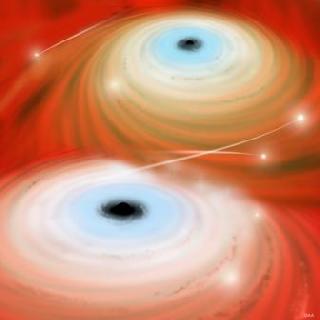
An artist's conception of two black holes are about to merge.
CAMBRIDGE, MASSACHUSETTES (BNS): A galaxy's core is a busy place, crowded with stars swarming around an enormous black hole.
When galaxies collide - the two Black Holes spiral toward each other merging to make an even bigger gravitational monster. The monster goes on a rampage.
The merger kicks the black hole into surrounding stars. There it finds a hearty meal, shredding and swallowing stars at a rapid clip.
A new research by Nick Stone and Avi Loeb said upcoming sky surveys might offer astronomers a way to catch a gorging black hole "in the act."
Before the merger, as the two black holes whirl around each other, they stir the galactic center like the blade of a blender. Their strong gravity warps space, sending out ripples known as gravitational waves.
When the black holes merge, they emit gravitational waves more strongly in one direction. That inequality kicks the black hole in the opposite direction like a rocket engine, the researchers said.
"That kick is very important. It can shove the black hole toward stars that otherwise would have been at a safe distance," said Stone.
A star's tidal disruption will let astronomers pinpoint the galaxy containing the recently merged black-hole binary.
By correlating the galaxy's redshift (a change in its light that's caused by the expanding universe) with an accurate distance, astronomers can infer the equation of state of dark energy, according to a release by Harvard Smithsonian Centre for Astrophysics.
In other words, researchers can learn more about the force that's accelerating cosmic expansion, and which dominates the cosmic mass/energy budget today.
"Instead of 'standard candles' like supernovae, the black hole binary would be a 'standard siren.' Using it, we could create the most accurate cosmic 'ruler' possible," stated Loeb.
Finding a merged black hole also would allow theorists to explore a new regime of Einstein's general theory of relativity.
"We could test general relativity in the regime of strong gravity with unprecedented precision," said Loeb.
 Previous Article
Previous Article Next Article
Next Article












The Indian Air Force, in its flight trials evaluation report submitted before the Defence Ministry l..
view articleAn insight into the Medium Multi-Role Combat Aircraft competition...
view articleSky enthusiasts can now spot the International Space Station (ISS) commanded by Indian-American astr..
view article